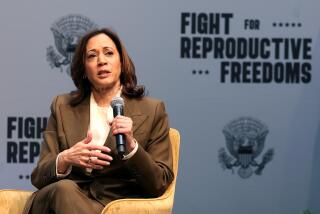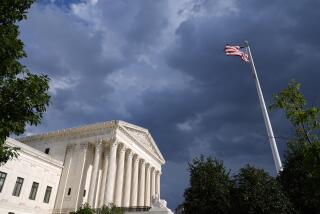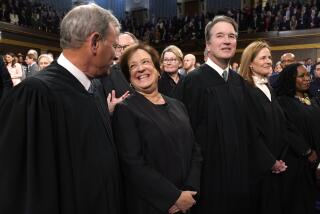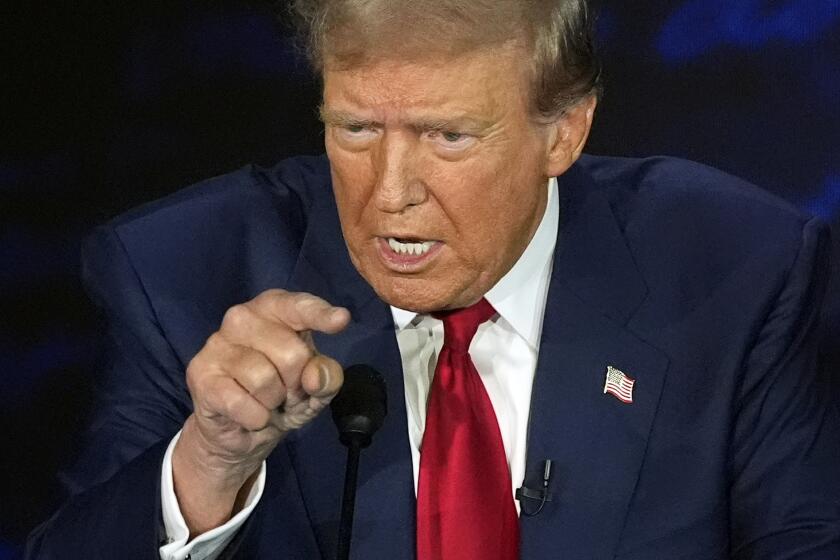Courts Have Made Hash of Privacy Since Roe vs. Wade
- Share via
Justice Lewis F. Powell Jr.’s retirement from the Supreme Court and President Reagan’s nomination of Judge Robert H. Bork to fill the vacancy have renewed debate over an asserted constitutional right of privacy.
In 1973 Powell voted with a 7-2 majority in Roe vs. Wade to hold unconstitutional, under a privacy-right banner, scores of statutory restrictions on abortions. In succeeding cases the court insisted that the right of privacy prohibited legislative efforts to offer parents a role in abortion decisions, or to require special medical procedures or patient information when abortions were sought. Powell joined the most recent rulings, by slim 5-4 majorities.
Bork’s appointment to the court will probably result in its renunciation of right-to-privacy pronouncements. He authored an opinion as a circuit judge rejecting a homosexual’s claim that a constitutional right of privacy protected his service in the Navy and disparaged the doctrine as a judicial invention. And Bork testified before the Senate Judiciary Committee that Roe vs. Wade was “an unconstitutional decision, a serious and wholly unjustifiable judicial usurpation of state legislative authority.”
The privacy-right debate is illuminated by sharply distinguishing between privacy interests or values protected by the Constitution and a constitutional right of privacy.
The privacy of religious belief is protected by the prohibition in Article VI of the Constitution against any religious test as a condition to holding any office under the United States. The privacy of opinion, beliefs or associations is protected by the First Amendment. The Fifth Amendment’s prohibition against compulsory self-incrimination safeguards innermost secrets from invasion by government. Similarly, the Fourth Amendment protects reasonable expectations of privacy from unreasonable government intrusions. Thus, electronic surveillance or wiretapping by law-enforcement officials or searches of homes or businesses can ordinarily be justified only by warrants. The Third Amendment protects the privacy of the home.
Express provisions in the Constitution thus clearly promote privacy interests. But no independent right of privacy is discoverable in the text.
The Supreme Court exuberantly decreed a constitutional right of privacy in the 1965 landmark case of Griswold vs. Connecticut, holding unconstitutional a statute proscribing contraceptive use by married persons. Speaking for the court, Justice William O. Douglas reasoned that the First, Third, Fourth and Fifth Amendments secured privacy values. These guarantees, he Delphically declared, “have penumbras, formed by emanations” that create a right of privacy for the marital bedroom. Douglas declined to enlarge on how the court could identify “penumbras” made from emanations in future cases, perhaps confident that the justices would know a constitutional penumbra when they saw one.
Douglas rhetorically asked, “Would we allow the police to search the sacred precincts of marital bedrooms for telltale signs of the use of contraceptives?” But in Griswold the police had not searched a bedroom and the defendants were not a married couple; rather, a licensed physician was accused of aiding and abetting an illegal act.
Douglas’ fears of government intrusion on marital privacy were conjured up to invent a constitutional right of privacy. But Connecticut’s sensible enforcement of its birth-control statute demonstrated that elected officials are alert to privacy values that would continue to thrive without the Supreme Court’s manipulating the Constitution.
As Justice Oliver Wendell Holmes observed, legislatures are every bit the guardian of the liberties and welfare of the people as the courts are. The constitutional right of privacy assumed juggernaut status as applied to abortion laws by the Supreme Court, whose rulings include the nullification of requirements that parents be notified before their daughters undergo abortions and the prohibition of a state from supplying a woman with accurate information that might discourage an abortion. How the supply of truthful information by the government invades privacy is not self-evident.
The overarching question raised by the Supreme Court’s abortion decisions is not whether the Constitution was intended to protect some types of privacy--it clearly was--or whether privacy values should be important--they certainly should be--but whether we want to permit the justices to employ undefined and undefinable “penumbras” to fasten on the nation their personal views of privacy rights. Rejecting a constitutional right of privacy would not forbid legislative or executive bodies from embracing pro-choice laws or programs, like California’s 1967 pro-abortion statute signed by then-Gov. Ronald Reagan.
A year ago the court denied the argument that consensual homosexual sodomy was protected by a constitutional right to privacy. Justice Byron R. White, writing for the majority, warned that “the court is most vulnerable and comes nearest to illegitimacy when it deals with judge-made law having little or no cognizable roots in the language or design of the Constitution.” By indulging in such extravaganzas, White remonstrated, “the judiciary necessarily takes to itself . . . authority to govern the country without express constitutional authority.”
More to Read
Get the L.A. Times Politics newsletter
Deeply reported insights into legislation, politics and policy from Sacramento, Washington and beyond. In your inbox twice per week.
You may occasionally receive promotional content from the Los Angeles Times.










